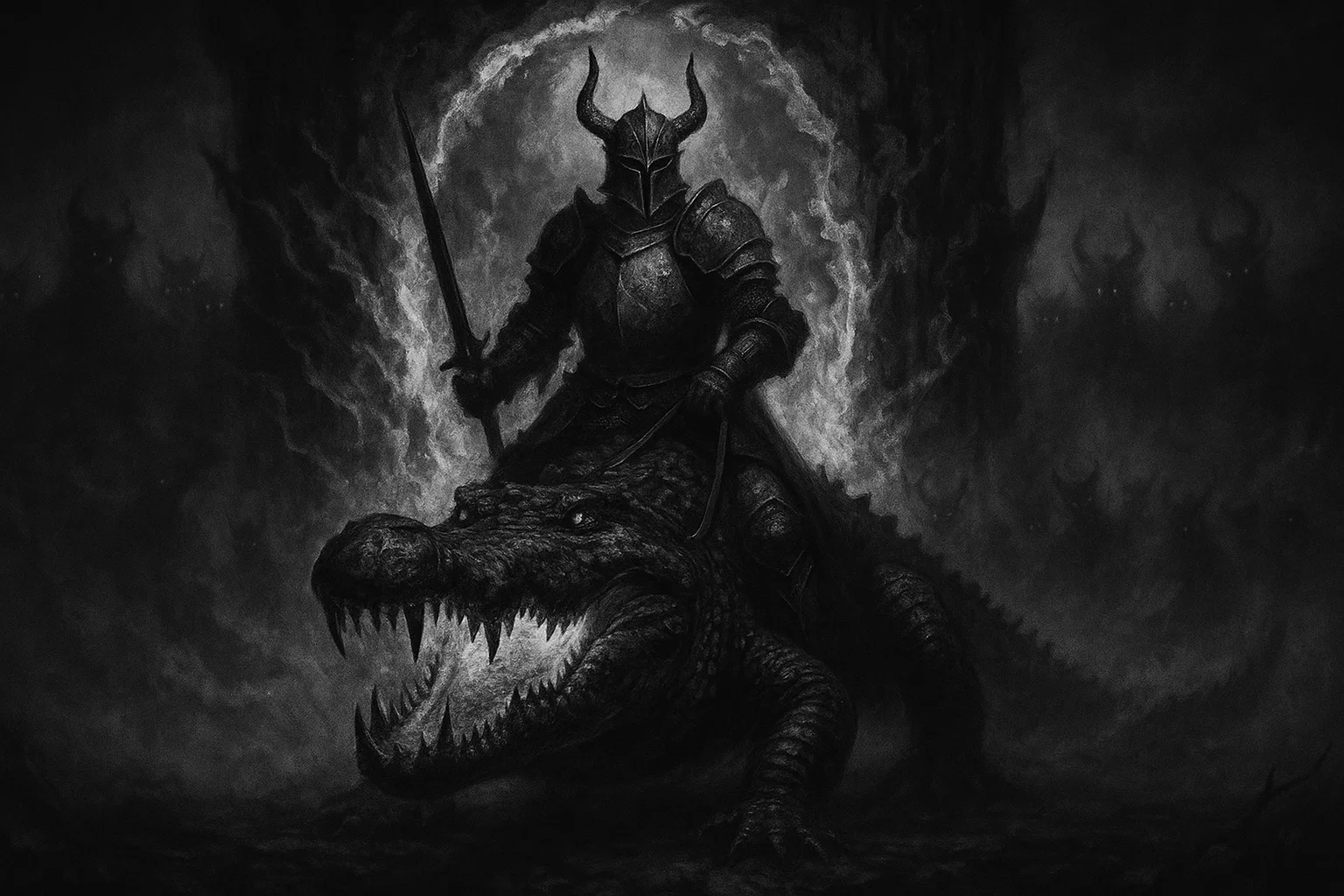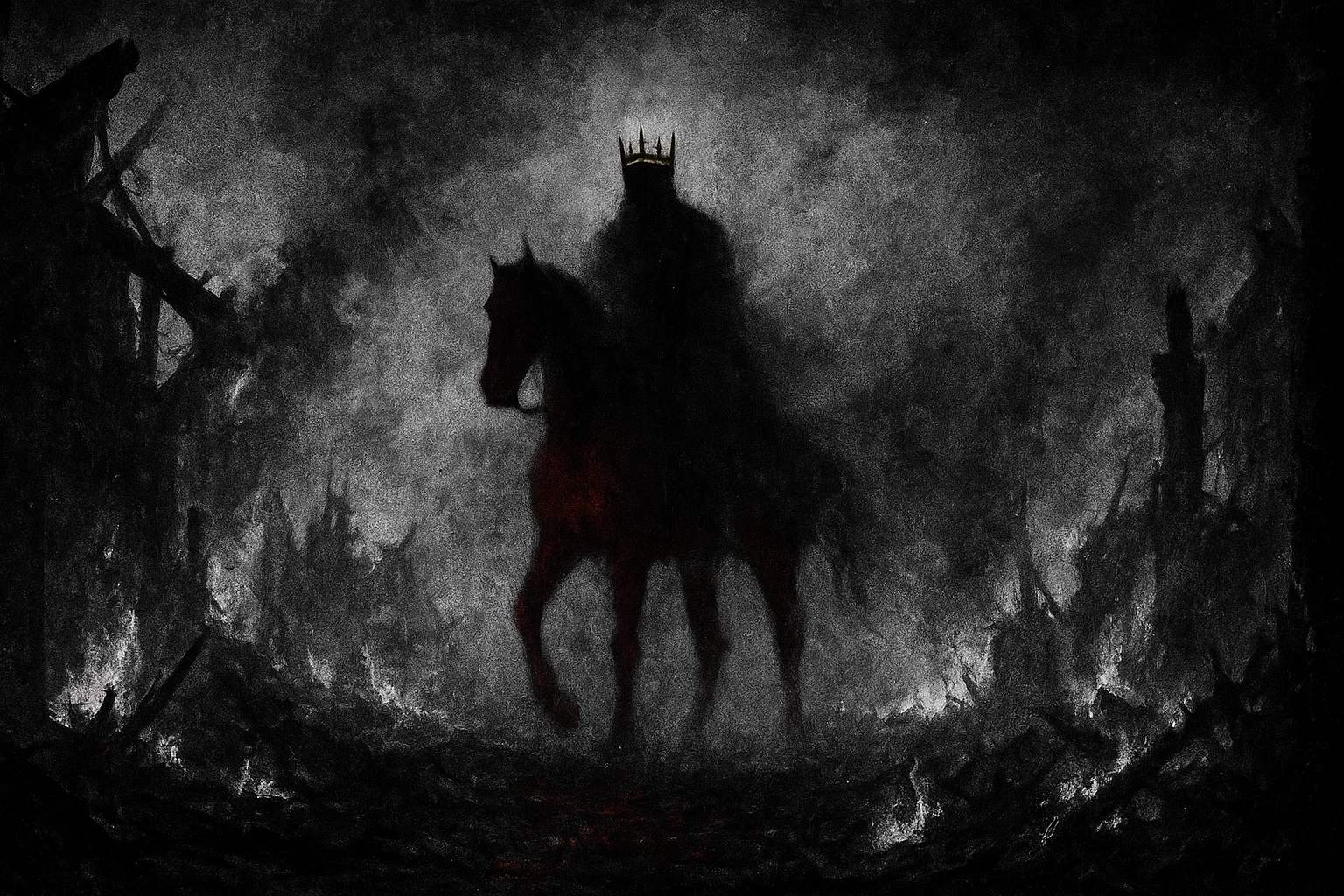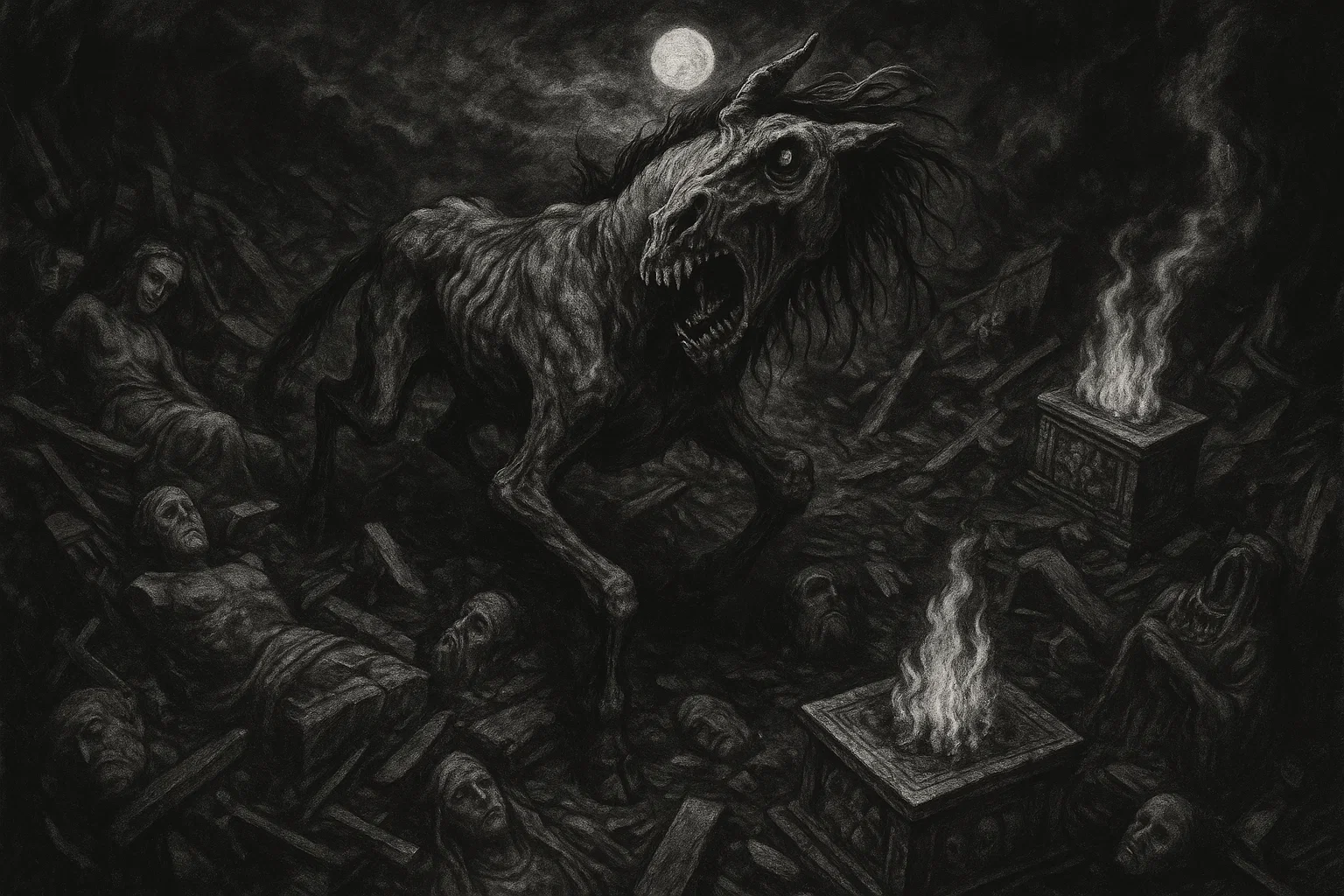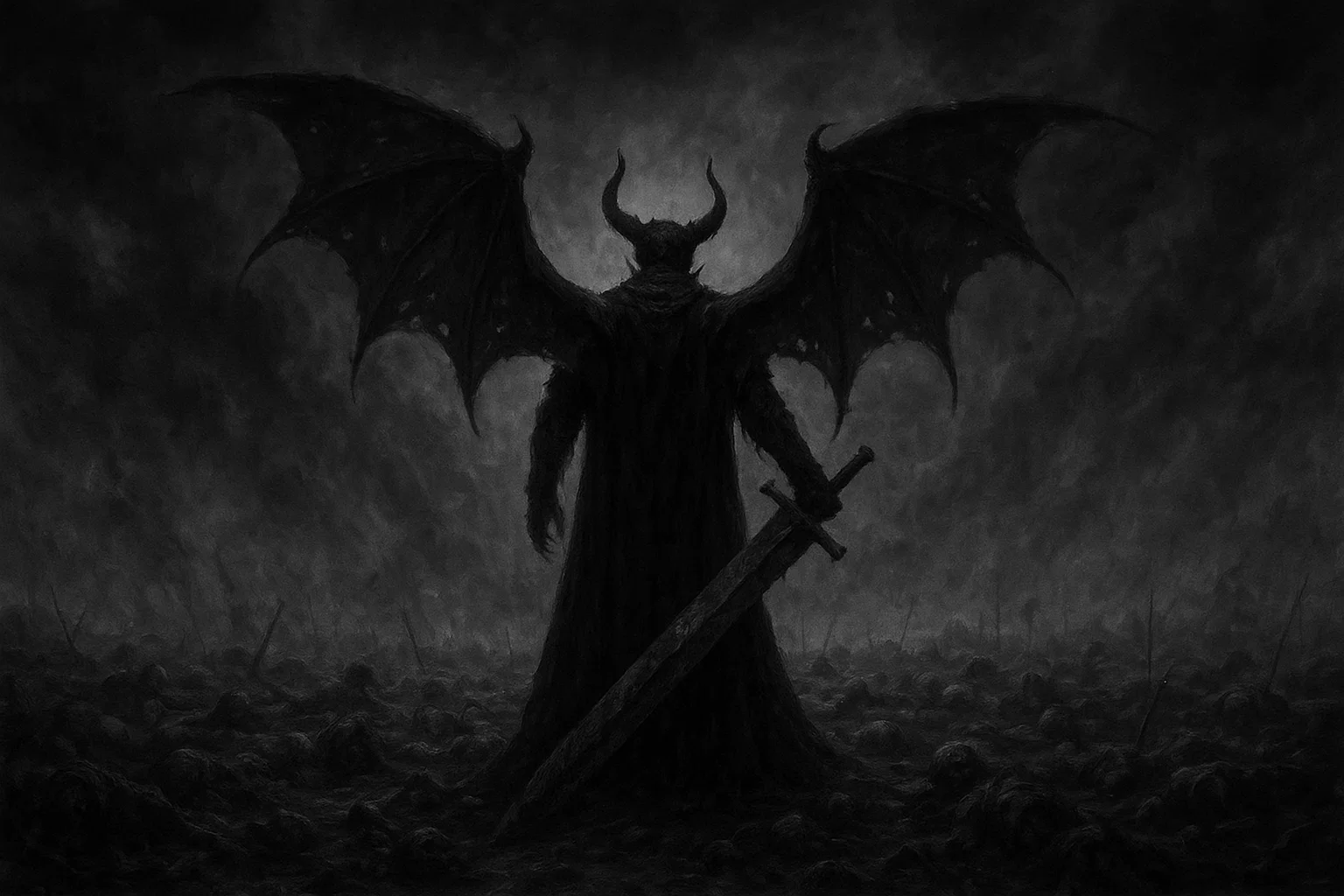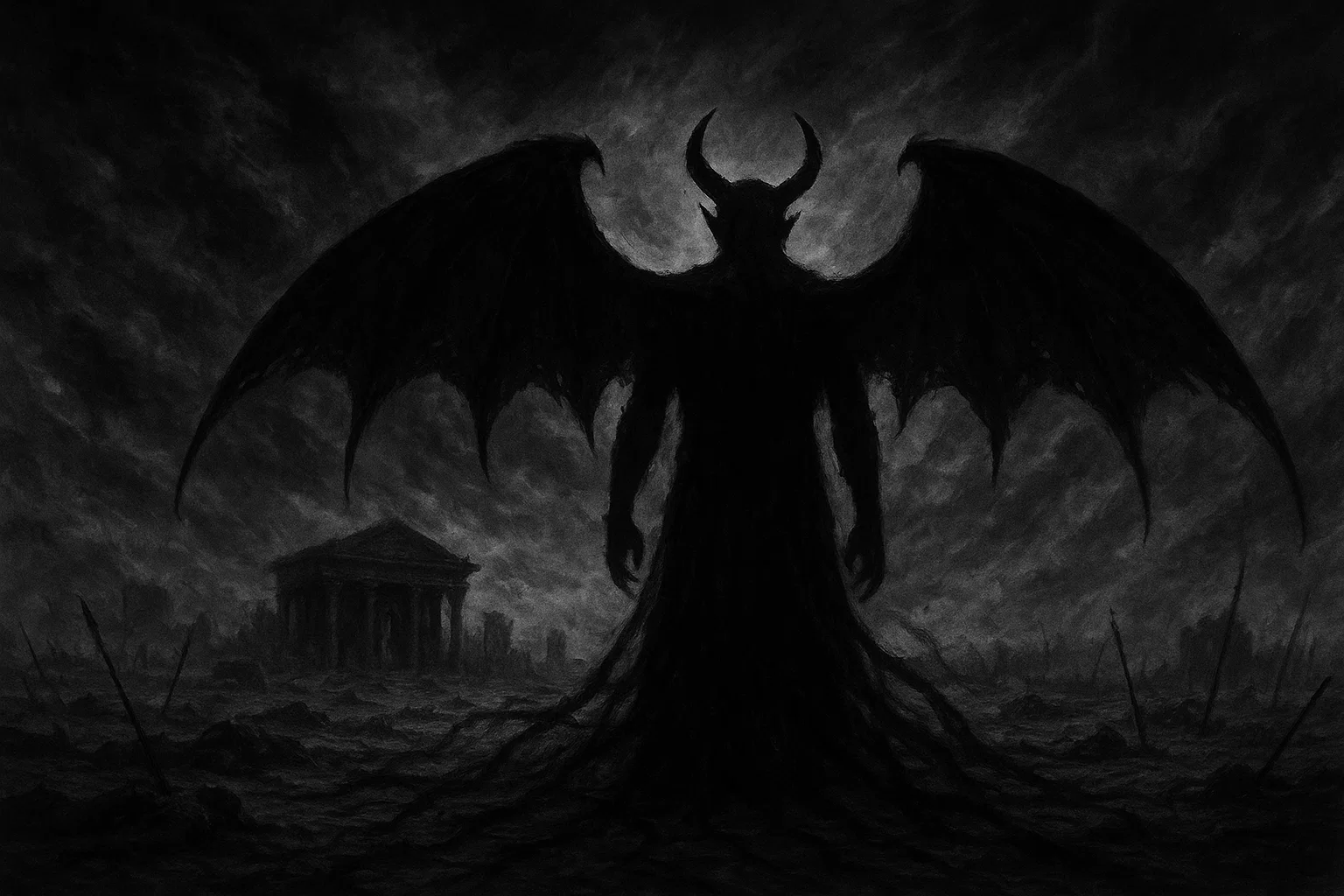In the shadowed annals of demonology, few figures captivate as Sallos, a Great Duke of Hell whose powers twist the delicate threads of human affection into infernal snares. Known for his deceptive charm, Sallos lures mortals with promises of love, only to bind them in webs of obsession and betrayal.
His presence in ancient grimoires like the Ars Goetia sparks questions: How does a demon of warlike visage wield the subtle art of romance? What dark motives drive his influence over hearts? Can his temptations be resisted in a world craving connection?
As the 19th spirit among King Solomon’s bound demons, Sallos commands awe and fear, his dominion over 30 legions hinting at a formidable yet enigmatic role in hell’s hierarchy. His crocodile mount and ducal crown paint a paradox—a warrior whose battlefield is the human soul. This article delves into Sallos’s sinister legacy, unraveling his origins, powers, and the perilous allure that has haunted occult lore for centuries.
Why does Sallos appear so serene, yet serve such a malevolent purpose? How have ancient myths shaped his terrifying reputation? Join us as we explore the depths of this infernal duke’s influence, from his etymological roots to his place among hell’s elite, revealing the dangers lurking behind his promises of love.
Table of Contents
Key Information
| Aspect | Details |
|---|---|
| Name | Sallos, Saleos, Zaleos, Zaebos |
| Title | Great Duke of Hell, Great Earl (per Johann Weyer), Grand Count (per Dictionnaire Infernal) |
| Gender | Male |
| Role | Sows temptation through love and lust, manipulates emotions to disrupt human harmony |
| Hierarchy | Duke (19th spirit in Ars Goetia), below Kings and Princes, commands 30 legions |
| Servitors | Leads 30 legions of lesser demons, specific names not detailed in primary texts |
| Superior Demon | Operates under Lucifer or Goetic kings like Asmoday or Amon, though not explicitly named |
| Powers | Induces obsessive love, incites lust, reveals hidden desires, manipulates emotions, speaks on creation |
| Appearance | Gallant soldier on a crocodile, wearing a ducal crown, with hair shifting between black and orange, aura alternating gold and silver |
| Etymology | Possibly from Hebrew שאלוש (Sha’alosh, questioning/seeking), or Greek saleuo (to shake/stir); linked to emotional agitation |
| Associated Figures | Bound by King Solomon, parallels with love demons like Zepar and Sitri, no direct familial ties |
| Weaknesses | Vulnerable to magical circles, holy invocations, Archangel Anael, and Saint Raphael |
| Opposing Angel/Saint | Archangel Anael (Venusian love), Saint Raphael (protector against emotional temptation) |
| Equipment/Tools | Sword (martial authority), ducal crown (noble rank), no additional weapons noted |
| Pantheon | Abrahamic demonology, rooted in Christian and Jewish occult traditions |
Etymology
The name Sallos carries a sinister resonance, its origins obscured by the mists of ancient languages and demonic distortions. Likely derived from the Hebrew שאלוש (Sha’alosh), it suggests “questioning” or “seeking,” reflecting Sallos’s role in probing the deepest desires of the human heart to exploit them. This root aligns with his ability to uncover hidden affections, turning curiosity into a tool for temptation.
Alternatively, the variant Saleos may trace to the Greek saleuo, meaning “to shake” or “stir,” evoking the emotional turmoil Sallos incites through lustful passions. This etymology hints at his power to destabilize relationships, stirring hearts into chaos under the guise of love. The shift from Saleos to Zaleos or Zaebos suggests Latinization during the Christianization of pagan deities, a common practice to demonize older gods.
Some scholars propose connections to Semitic terms for “peace” or “serenity,” a cruel irony given Sallos’s malevolent intent. In Aramaic, roots like shalu (calm) could imply his deceptive facade, masking corruption with tranquility. Medieval scribes, translating across cultures, may have altered the name to fit Christian demonological frameworks, blending Hebrew, Greek, and Latin influences.
Further speculation ties Sallos to ancient Mesopotamian or Egyptian deities associated with love or war, though no direct evidence confirms this. His name’s fluidity across grimoires—Pseudomonarchia Daemonum (1577), Ars Goetia (~1650), and Dictionnaire Infernal (1818)—reflects centuries of linguistic evolution, each variant encoding his role as a manipulator of human bonds.
This etymological complexity underscores Sallos’s enduring enigma, a name that both reveals and conceals his infernal purpose.
You May Also Like: The Werewolf of Morbach: Truth or Terrifying Legend?
What Does the Demon Sallos Look Like?
Sallos appears as a gallant soldier, his form both commanding and deceptively alluring. Clad in medieval armor, he rides a crocodile, a beast symbolizing primal power and cunning patience, its scales glinting under infernal light. His ducal crown, adorned with jagged horns, marks his noble rank, while his shifting hair—black to orange—mirrors his volatile aura, fluctuating between gold and silver.
His visage is strikingly handsome, with piercing eyes that seem to peer into the soul, exploiting vulnerabilities. Some accounts describe Sallos as a floating head, his body invisible, enhancing his eerie presence. This form, noted in modern occult lore, suggests a spectral manipulation, aligning with his ability to infiltrate thoughts.
The sword at his side, though rarely drawn, signifies authority rather than violence, complementing his pacifist facade. Unlike grotesque demons, Sallos’s appearance disarms, inviting trust before ensnaring victims. His crocodile mount, a nod to ancient river gods, underscores his connection to emotional currents, making his form a chilling blend of nobility and menace.
Historical and Mythological Background
Sallos’s origins are shrouded in the interplay of Abrahamic demonology and earlier mythologies, his role as a Great Duke emerging from the synthesis of Jewish, Christian, and possibly pagan traditions.
As one of the 72 spirits bound by King Solomon, Sallos is rooted in Solomonic legend, where he served the king’s will, manipulating emotions to maintain order. His story, however, extends beyond these texts, hinting at connections to ancient deities and infernal narratives.
Solomonic Binding and Temple Service
In Jewish mysticism, Sallos was among the demons compelled by King Solomon to aid in constructing the Temple. Grimoires like the Lesser Key of Solomon describe him influencing workers’ relationships, sowing affections to ensure cooperation. This tale portrays Sallos as a tool of infernal utility, his love-inducing powers twisted to serve human ambition, yet at the cost of spiritual peril.
One apocryphal story recounts Solomon summoning Sallos to resolve a feud between two lovers in his court. The demon’s intervention sparked an obsessive union, strengthening a political alliance but binding the lovers to infernal influence. This narrative, echoed in medieval texts, warns of Sallos’s ability to mask corruption with harmony, a recurring theme in his mythology.
Possible Pagan Origins
Scholars speculate that Sallos may derive from demonized pagan deities, particularly those tied to love or war. His crocodile mount and martial form suggest parallels with Sobek, the Egyptian crocodile god of strength and protection, whose attributes could have been warped by Christian scribes into a demonic figure.
Similarly, his love-inducing powers echo Aphrodite or Ishtar, goddesses of passion whose worship was vilified as Christianity spread.
In Mesopotamian lore, deities like Nanshe, associated with water and social harmony, share thematic links with Sallos’s aquatic symbolism and emotional manipulation. These connections, though speculative, suggest his origins lie in pre-Christian pantheons, where gods of fertility and affection were recast as demons to suppress rival faiths.
The absence of direct Middle Eastern references strengthens this theory, pointing to a deliberate obscuring of his roots.
You May Also Like: The Ivanov Directive | Horror Story
Medieval Legends of Courtly Temptation
During the Middle Ages, Sallos appeared in tales of courtly love tainted by infernal pacts. One legend tells of a French knight who invoked Sallos to win a lady’s heart, only to find her love turned to obsession, driving her to madness. The demon’s sigil, etched in secret, was said to bind her soul, a cautionary tale recorded in occult circles about the dangers of his gifts.
Another story involves a sorcerer who summoned Sallos to unite warring noble families through marriage. The resulting union, though peaceful, led to a lineage cursed with infidelity, suggesting Sallos’s long-term corruption. These narratives, circulating in European grimoires, depict him as a subtle manipulator, exploiting human desires for infernal ends.
Fallen Angel Mythos
Some apocryphal texts cast Sallos as a fallen angel, once a servant of divine love under Archangel Anael. His rebellion during Lucifer’s fall twisted his purpose, turning sacred affection into a tool for damnation. In this myth, Sallos wanders hell’s domains, yearning for lost grace while tempting mortals with fleeting pleasures, his tragedy fueling his cunning.
This narrative portrays Sallos allying with demons like Zepar in schemes to destabilize human societies through love. One tale describes him aiding Asmoday in a plot to seduce a pious queen, her fall sparking a kingdom’s ruin. Such stories emphasize Sallos’s role as a strategic tempter, his peaceful facade masking a relentless agenda.
Modern Occult and Pop Culture
In contemporary occultism, Sallos is invoked in rituals for romantic manipulation, his powers amplified by modern interpretations. Pop culture, including occult-themed novels and games, reimagines him as a spectral figure who haunts lovers’ dreams, whispering desires that lead to ruin. A fictional tale from a 2020 horror anthology depicts Sallos as a shadowy matchmaker, orchestrating doomed romances that feed hell’s chaos.
These modern myths expand Sallos’s role, portraying him as a manipulator of digital-era relationships, exploiting social media’s emotional vulnerabilities. His influence in online forums, where users share summoning experiences, suggests a resurgence of interest, with practitioners warning of his subtle but devastating impact.
You May Also Like: Complete Guide to Oklahoma Bigfoot Sightings (1942–2025)
Historical Mentions
| Text/Grimoire | Year | Description | Excerpt |
|---|---|---|---|
| Pseudomonarchia Daemonum | 1577 | Great Earl, gallant soldier on a crocodile, crowned, peaceful, induces love. | “Saleos [Zaleos] is a great earle, he appeareth as a gallant souldier, riding on a crocodile, and weareth a dukes crowne, peaceable, &c.” |
| Ars Goetia (Lesser Key of Solomon) | ~1650 | Great Duke, gallant soldier on a crocodile, ducal crown, causes love, rules 30 legions. | “The Nineteenth Spirit is Sallos (or Saleos). He is a Great and Mighty Duke, and appeareth in the Form of a gallant Soldier riding on a Crocodile, with a Ducal Crown on his head, but peaceably. He causeth the Love of Women to Men, and of Men to Women; and governeth 30 Legions of Spirits.” |
| Dictionnaire Infernal | 1818 | Grand-count, handsome soldier on a crocodile, ducal crown, mild-tempered. | “Zaebos, grand-count of the underworld. He has the figure of a handsome soldier mounted on a crocodile; his head is adorned with a ducal crown, He is gentle in character…” |
Sallos’s Powers and Abilities
Sallos wields a sinister array of powers centered on manipulating human emotions, particularly love and lust. His primary ability is inducing obsessive love, creating intense, often destructive attractions between individuals. Unlike demons like Astaroth, who blend knowledge with temptation, Sallos focuses exclusively on emotional corruption, making his influence uniquely perilous.
He can reveal hidden desires, exposing suppressed feelings to ignite passions that disrupt lives. This power, noted in the Ars Goetia, tempts by forcing confrontations with forbidden affections, leading to infidelity or social ruin. Sallos also incites lustful compulsion, a darker twist on his love-inducing abilities, pushing physical desires that erode moral boundaries.
In modern occult lore, Sallos is credited with emotional manipulation through dreams, planting visions of ideal partners that lead to real-world obsessions. Pop culture, such as occult-themed video games, portrays him amplifying online attractions, turning fleeting digital connections into consuming fixations. These newer powers reflect his adaptability to modern vulnerabilities.
His authority over creation myths, though less emphasized, allows him to weave deceptive narratives, convincing mortals of divine sanction for their desires. This power, cited in the Pseudomonarchia Daemonum, manipulates trust, aligning romantic pursuits with cosmic significance to deepen corruption.
Sallos’s legions amplify his reach, deploying lesser spirits to whisper temptations or orchestrate chance encounters. Unlike common demonic traits like possession, his abilities are subtle, exploiting natural human chemistry to mask infernal intent. This makes his corruption insidious, as victims perceive their actions as self-driven.
| Power/Ability | Description | Source | How It Tempts/Corrupts Humans | Countermeasure |
|---|---|---|---|---|
| Inducing Obsessive Love | Creates intense, mutual attractions that spiral into obsession. | Ars Goetia | Leads to destructive relationships, betrayals, and loss of autonomy. | Archangel Anael’s invocation; Venusian talismans. |
| Revealing Hidden Desires | Exposes suppressed emotions, forcing confrontations with forbidden passions. | Pseudomonarchia Daemonum | Encourages infidelity, reckless decisions, and moral collapse. | Saint Raphael’s prayers; holy water cleansing. |
| Inciting Lustful Compulsion | Fuels physical desires, turning attraction into consuming urges. | Dictionnaire Infernal | Promotes immorality, dependency, and spiritual entrapment. | Magical circles with divine names; fasting. |
| Dream Manipulation | Plants romantic visions in dreams, leading to real-world fixations. | Modern occult lore | Creates unattainable ideals, fostering despair or obsession. | Archangel Michael’s protection; dream wards. |
| Creation Myth Authority | Speaks convincingly on cosmic origins, aligning desires with false divinity. | Ars Goetia | Deceives mortals into believing sinful acts are sanctioned. | Solomon’s seals; scriptural study. |
You May Also Like: Crocell – The Mysterious Demon Duke. Powers, Legends, and Lore
How to Counter Sallos’s Powers
Countering Sallos demands robust spiritual defenses to resist his emotional manipulations. Magical circles inscribed with divine names, such as YHVH or Elohim, bind his influence, preventing intrusion. These, rooted in Solomonic traditions, must be drawn with precision, using salt or chalk to create sacred barriers.
Archangel Anael, tied to Venus, counters Sallos’s love-inducing powers by restoring natural affections. Invoking Anael through prayers or Venusian sigils disrupts his artificial bonds. Similarly, Saint Raphael protects against emotional temptations, his intercession shielding hearts from infernal influence.
Ritual countermeasures include burning frankincense or myrrh, whose holy scents repel Sallos’s presence. Amulets engraved with crosses or pentacles aligned with Mercury (for clarity) weaken his hold. Psalms, particularly Psalm 91, recited during exorcisms, disrupt his subtle approaches, forcing retreat.
Personal vigilance is crucial. Meditation on virtues like temperance and chastity fortifies the will, countering Sallos’s exploitation of loneliness. Community prayers, invoking divine light, amplify resistance, transforming individual weakness into collective strength. These combined efforts ensure protection against his seductive corruption.
Sallos’s Role in the Hierarchy of Hell
In the infernal hierarchy of the Ars Goetia, Sallos reigns as a Great Duke, the 19th spirit among 72 demons. This rank places him below Kings like Baal and Princes like Vassago, but above lesser Knights and Presidents. Commanding 30 legions, approximately 150,000 spirits, he wields significant authority within hell’s structured chaos.
Sallos rules a domain in hell’s southern or western regions, associated with water and emotional currents, possibly near infernal rivers symbolizing passion’s flow. His legions, though unnamed in primary texts, are likely specialized spirits skilled in emotional manipulation, amplifying his love-inducing campaigns. These servitors act as whispers in mortal minds, orchestrating temptations across vast distances.
His superiors include Lucifer, the ultimate authority, and Goetic kings like Asmoday or Amon, who oversee broader infernal strategies. Sallos’s role complements theirs, targeting human vulnerabilities to destabilize societies. Allied demons, such as Zepar and Sitri, share his focus on lust and love, forming a cabal that manipulates romantic entanglements to sow discord.
Adversaries within hell include demons like Andras, whose violent tendencies clash with Sallos’s subtle approach. Rivalries arise from competing agendas, as Sallos’s pacifist facade masks a cunning that threatens more overt demons. His relationships, built on strategic necessity, position him as a key player in hell’s emotional warfare, exploiting human hearts to advance infernal goals.
Astrological Associations and Symbolism
Sallos’s astrological ties center on Venus, the planet of love, lust, and beauty, amplifying his powers during Friday transits and Libra or Taurus seasons. His influence peaks between September 23rd and October 3rd, aligning with early Libra, a period of emotional balance he exploits. The number 19, his Goetic rank, symbolizes introspection, while 30 (his legions) reflects discipline in temptation.
Elementally, Sallos blends water (emotional depth) and air (intellectual seduction), reflecting his dual manipulation of feelings and thoughts. Copper, a Venusian metal, conducts his energies, used in ritual talismans. Emerald and rose quartz enhance his influence, symbolizing love’s allure and danger.
Colors like green (growth, envy) and red (passion) dominate his symbolism, with sandalwood incense invoking his presence. His crocodile mount ties to ancient water deities, representing primal desire restrained by intellect. These associations, rooted in occult traditions, make Sallos a potent figure in astrological magic.
| Association | Details |
|---|---|
| Planet | Venus |
| Zodiac Sign | Libra, Taurus |
| Element | Water, Air |
| Number | 19, 30 |
| Day | Friday |
| Metal | Copper, Silver |
| Color | Green, Red |
| Precious Stone/Crystal | Emerald, Rose Quartz, Malachite |
| Incense | Sandalwood, Rose, Jasmine |
| Plant | Aster, Rose |
You May Also Like: Buné: Demon King of Riches and Necromancy
Sallos’s Sigil
The sigil of Sallos, found in the Ars Goetia, is a complex glyph of curved lines and loops, symbolizing entwined affections and emotional entrapment. Drawn in green ink on copper, it activates his powers during love rituals, serving as a conduit for his infernal influence. Its balanced design reflects his deceptive harmony, masking malevolent intent.
In rituals, the sigil is placed on altars, surrounded by red candles and sandalwood smoke, to summon Sallos. Its loops mimic the binding of lovers’ souls, a visual echo of his corrupting abilities. Variations across grimoires maintain core elements, ensuring efficacy in evocations.
Beyond the sigil, symbols like the crocodile and ducal crown amplify his presence. Offerings of wine or blood (in extreme rituals) strengthen his response, aligning with his Venusian and primal associations.
| Symbol/Item | Association/Meaning | Use in Rituals |
|---|---|---|
| Crocodile | Primal desire, patience, water’s power | Effigy for summoning, symbolizing controlled passion |
| Ducal Crown | Infernal nobility, authority | Drawn or worn to invoke rank and respect |
| Sword | Martial clarity, emotional precision | Held for protection during evocations |
| Emerald | Love, envy, Venusian energy | Altar stone for romantic spells |
| Sandalwood Incense | Seduction, emotional allure | Burned to attract Sallos’s presence |
| Rose | Passion, dangerous affection | Offered in love petitions |
| Copper Item | Venusian conductivity, emotional flow | Talisman for binding desires |
| Red Candle | Lust, passion, energy | Lit to ignite romantic rituals |
| Wine | Offering of indulgence, Venusian tribute | Poured as a summoning gift |
Comparison with Other Demons
| Demon | Rank | Powers | Appearance | Unique Traits vs. Sallos |
|---|---|---|---|---|
| Astaroth | Duke | Reveals secrets, induces love, teaches sciences | Ugly angel on dragon, viper in hand | Broader knowledge focus; love is deceptive, unlike Sallos’s obsessive focus |
| Sitri | Prince | Causes love, exposes secrets | Leopard with griffin wings | Aggressive lust inducement; less subtle than Sallos’s emotional manipulation |
| Beleth | King | Causes love, commands musicians | Terrifying on pale horse | Requires taming; musical element absent in Sallos, fiercer demeanor |
| Zepar | Duke | Induces love, causes infertility | Soldier in red armor | Adds destructive infertility; contrasts Sallos’s focus on harmony |
| Gusion | Duke | Reveals past/future, grants honor | Human-like xenophilus | Divinatory focus; lacks Sallos’s romantic specialization |
| Eligos | Duke | Foretells wars, discovers hidden things | Knight with serpent | Martial strategy; no emotional manipulation like Sallos |
| Botis | President/Earl | Foretells future, reconciles friends | Viper, then horned man with sword | Broader reconciliation; shape-shifting vs. Sallos’s fixed form |
| Bathin | Duke | Transports people, teaches herbs/stones | Strong man with serpent tail | Travel and knowledge; no love focus, unlike Sallos |
| Purson | King | Finds treasures, reveals past/future | Lion-faced on bear, viper in hand | Treasure-seeking; higher rank, no emotional manipulation |
| Marax | Earl/President | Teaches astronomy, herbs | Bull with human face | Scientific focus; lacks Sallos’s temptation through love |
You May Also Like: Who Is the Demon Gremory in Ars Goetia?
Conclusion
Sallos, the Great Duke of Hell, embodies the perilous allure of infernal love, his powers weaving temptation into the fabric of human desire. From his Solomonic origins to modern occult reinterpretations, he remains a chilling figure, exploiting emotions to sow chaos. His crocodile mount and ducal crown mask a sinister intent, making him a formidable yet subtle adversary in demonology.
The study of Sallos reveals the complexity of infernal hierarchies, where even a pacifist facade serves malevolent ends. His enduring presence in grimoires and pop culture underscores the timeless danger of unchecked desires. As occult interest grows, Sallos’s legacy warns of the fine line between love and damnation, urging vigilance against his seductive wiles.

